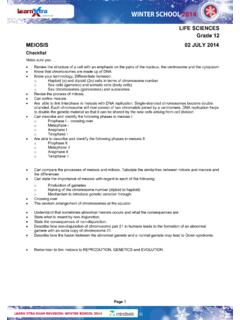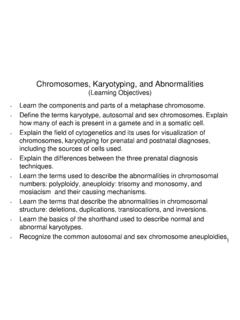Transcription of HAPTER 10 C D - NCERT
1 162 BIOLOGY. C HAPTER 10. C ELL C YCLE AND C ELL D IVISION. cell cycle Are you aware that all organisms, even the largest, start their life from a M Phase single cell? You may wonder how a single cell then goes on to form such large organisms. Growth and reproduction are characteristics of cells , Significance of indeed of all living organisms. All cells reproduce by dividing into two, mitosis with each parental cell giving rise to two daughter cells each time they meiosis divide. These newly formed daughter cells can themselves grow and divide, giving rise to a new cell population that is formed by the growth and Significance of division of a single parental cell and its progeny. In other words, such meiosis cycles of growth and division allow a single cell to form a structure consisting of millions of cells .
2 C ELL cycle . Cell division is a very important process in all living organisms. During the division of a cell, DNA replication and cell growth also take place. All these processes, , cell division, DNA replication, and cell growth, hence, have to take place in a coordinated way to ensure correct division and formation of progeny cells containing intact genomes. The sequence of events by which a cell duplicates its genome, synthesises the other constituents of the cell and eventually divides into two daughter cells is termed cell cycle . Although cell growth (in terms of cytoplasmic increase). is a continuous process, DNA synthesis occurs only during one specific stage in the cell cycle . The replicated chromosomes (DNA) are then distributed to daughter nuclei by a complex series of events during cell division.
3 These events are themselves under genetic control. 2021-22. cell cycle AND CELL DIVISION 163. Phases of cell cycle A typical eukaryotic cell cycle is illustrated by human cells in culture. These cells divide once in approximately every 24 hours (Figure ). However, this duration of cell cycle can vary from organism to organism and also from cell type to cell type. Yeast for example, can progress M Phase through the cell cycle in only about 90 minutes. The cell cycle is divided into two basic phases: l Interphase l M Phase ( mitosis phase). The M Phase represents the phase when the actual cell division or mitosis occurs and the interphase represents the phase between two successive M phases. It is significant to note Figure A diagrammatic view of cell cycle indicating formation of two cells that in the 24 hour average duration of cell from one cell cycle of a human cell, cell division proper lasts for only about an hour.
4 The interphase lasts more than 95% of the duration of cell cycle . The M Phase starts with the nuclear division, corresponding to the separation of daughter chromosomes (karyokinesis) and usually ends with division of cytoplasm (cytokinesis). The interphase, though called the resting phase, is the time during which the cell is preparing for division by undergoing both cell growth and DNA replication in an orderly manner. The interphase is divided into three further phases: l G1 phase (Gap 1). l S phase (Synthesis). l G2 phase (Gap 2) How do plants and animals continue to G1 phase corresponds to the interval between mitosis and initiation grow all their lives? of DNA replication. During G1 phase the cell is metabolically active and Do all cells in a plant divide all the time?
5 Continuously grows but does not replicate its DNA. S or synthesis phase Do you think all cells marks the period during which DNA synthesis or replication takes place. continue to divide in During this time the amount of DNA per cell doubles. If the initial amount all plants and of DNA is denoted as 2C then it increases to 4C. However, there is no animals? Can you increase in the chromosome number; if the cell had diploid or 2n number tell the name and the of chromosomes at G1, even after S phase the number of chromosomes location of tissues having cells that remains the same, , 2n. divide all their life in In animal cells , during the S phase, DNA replication begins in the higher plants? Do nucleus, and the centriole duplicates in the cytoplasm.
6 During the G2 animals have similar phase, proteins are synthesised in preparation for mitosis while cell growth meristematic continues. tissues? 2021-22. 164 BIOLOGY. You have studied Some cells in the adult animals do not appear to exhibit division ( , mitosis in onion root heart cells ) and many other cells divide only occasionally, as needed to tip cells . It has 16 replace cells that have been lost because of injury or cell death. These chromosomes in cells that do not divide further exit G1 phase to enter an inactive stage each cell. Can you called quiescent stage (G0) of the cell cycle . cells in this stage remain tell how many metabolically active but no longer proliferate unless called on to do so chromosomes will depending on the requirement of the organism.
7 The cell have at G 1 In animals, mitotic cell division is only seen in the diploid somatic phase, after S phase, cells . However, there are few exceptions to this where haploid cells divide and after M phase? by mitosis , for example, male honey bees. Against this, the plants can Also, what will be the DNA content of the show mitotic divisions in both haploid and diploid cells . From your cells at G 1, after S recollection of examples of alternation of generations in plants (Chapter 3). and at G 2 , if the identify plant species and stages at which mitosis is seen in haploid cells . content after M. phase is 2C? M PHASE. This is the most dramatic period of the cell cycle , involving a major reorganisation of virtually all components of the cell. Since the number of chromosomes in the parent and progeny cells is the same, it is also called as equational division.
8 Though for convenience mitosis has been divided into four stages of nuclear division (karyokinesis), it is very essential to understand that cell division is a progressive process and very clear-cut lines cannot be drawn between various stages. Karyokinesis involves following four stages: l Prophase l Metaphase l Anaphase l Telophase Prophase Prophase which is the first stage of karyokinesis of mitosis follows the S and G2 phases of interphase. In the S and G2 phases the new DNA. molecules formed are not distinct but intertwined. Prophase is marked by the initiation of condensation of chromosomal material. The chromosomal material becomes untangled during the process of chromatin condensation (Figure a). The centrosome, which had undergone duplication during S phase of interphase, now begins to move towards opposite poles of the cell.
9 The completion of prophase can thus be marked by the following characteristic events: l Chromosomal material condenses to form compact mitotic chromosomes. Chromosomes are seen to be composed of two chromatids attached together at the centromere. l Centrosome which had undergone duplication during interphase, begins to move towards opposite poles of the cell. Each centrosome radiates out microtubules called asters. The two asters together with spindle fibres forms mitotic apparatus. 2021-22. cell cycle AND CELL DIVISION 165. cells at the end of prophase, when viewed under the microscope, do not show golgi complexes, endoplasmic reticulum, nucleolus and the nuclear envelope. Metaphase The complete disintegration of the nuclear envelope marks the start of the second phase of mitosis , hence the chromosomes are spread through the cytoplasm of the cell.
10 By this stage, condensation of chromosomes is completed and they can be observed clearly under the microscope. This then, is the stage at which morphology of chromosomes is most easily studied. At this stage, metaphase chromosome is made up of two sister chromatids, which are held together by the centromere (Figure b). Small disc-shaped structures at the surface of the centromeres are called kinetochores. These structures serve as the sites of attachment of spindle fibres (formed by the spindle fibres) to the chromosomes that are moved into position at the centre of the cell. Hence, the metaphase is characterised by all the chromosomes coming to lie at the equator with one chromatid of each chromosome connected by its kinetochore to spindle fibres from one pole and its sister chromatid connected by its kinetochore to spindle fibres from the opposite pole (Figure b).
















